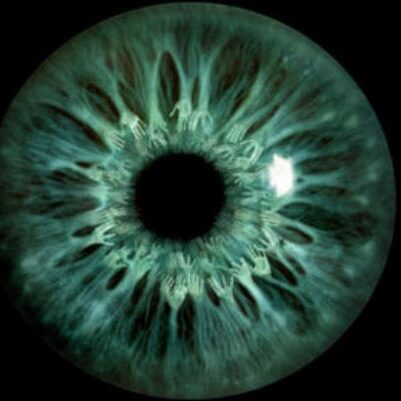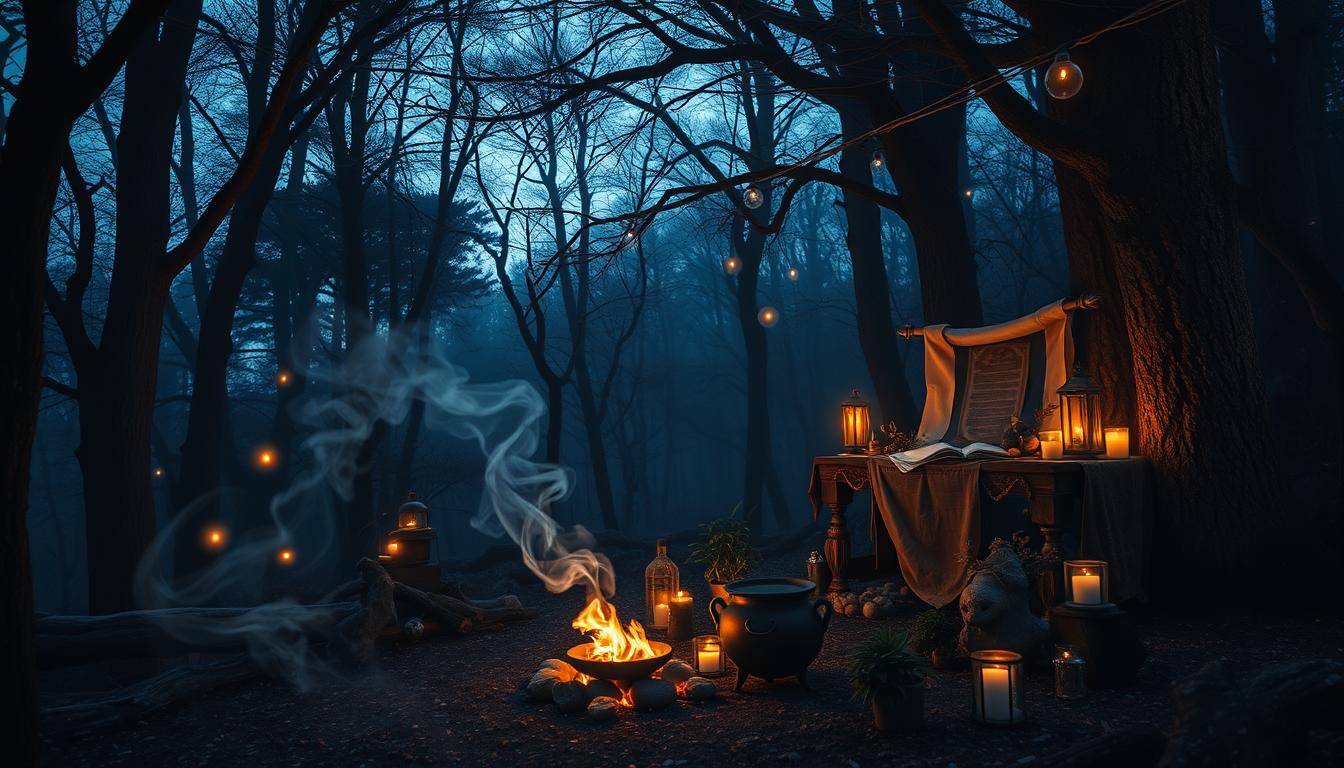It was a chilly autumn evening when Sarah, a curious student, found herself drawn to an unconventional bookstore. It was tucked away in the heart of the city. The air inside seemed to crackle with mysticism, catching her interest in witchcraft and the occult.
Surrounded by shelves full of esoteric books and crystals, Sarah wondered: is witchcraft real? The stories she heard growing up were often full of myth and misconception. Yet, a part of her wanted to explore this mysterious world more.
As she looked through the store, a book caught her eye – a guide to modern Pagan and Wiccan traditions. She was intrigued and found that witchcraft is alive and evolving. It’s not just a thing of the past, but a spiritual practice that still fascinates people worldwide.
Key Takeaways:
- Witchcraft is a real spiritual practice, different from how it’s often shown in media.
- Modern witches often call themselves Pagans. They follow nature-based religions and take part in rituals, ceremonies, and spellcasting.
- The early modern period saw many accused of witchcraft. This was often based on myths and wrong ideas.
- Wicca and other Pagan traditions still use witchcraft practices today. But they have changed a lot from the past.
- Witchcraft beliefs and practices differ around the world. There are global patterns and cultural variations.
Debunking the Myths: Separating Fact from Fiction
Many myths and misconceptions surround witchcraft. One big belief is that people accused of witchcraft back then were actually witches. But this idea is not true.
In Europe during the early modern times, about 90,000 people were accused of witchcraft. Half of them were put to death. But most of those accused didn’t see themselves as witches. Some even started believing they were witches after being tortured. Only a small group of “cunning people” actually practiced magic, not all of whom were seen as witches.
Myth: Witches Were Actually Witches
Many think those accused of witchcraft were actually practicing witches. But this is a big misconception about witchcraft. Most of the time, accusations came from personal conflicts, not real magic. The witches in history were not doing the magic everyone thinks they were.
“Around 90,000 people were accused of witchcraft during the early modern period in Europe, with about half being executed. However, the vast majority of those accused did not identify as witches, and some only came to believe they were witches after being tortured.”
It’s key to know that the idea of witches being real is a myth from movies and stories. Most of those accused didn’t practice witchcraft at all.
By clearing up the myths, we get a clearer picture of witchcraft myths and witches in history. This helps us question the old misconceptions about witchcraft. It also lets us see the real story behind this interesting topic.
The Gender Dynamics of Witchcraft Accusations
In Europe and North America, during witchcraft trials, gender was a big factor. Many women were accused and persecuted, more than men. This was true even though both genders were accused of witchcraft.
In New England, 78% of the 344 accused witches were women. In the Salem witch trials, 14 out of 19 people executed were women. From 1638 to 1725, women were much more likely to be accused and executed than men.
Men accused of witchcraft were often related to the accused women. Before the Salem trials, 16 out of 93 witch trials in New England ended in executions. Most of these victims were women.
The Puritan society was very patriarchal. Women had little power and were often accused of witchcraft to control them. This was a way to keep women in their place and show their power over them.
| Statistic | Value |
|---|---|
| Percentage of alleged witches in New England who were female | 78% |
| Percentage of people executed for witchcraft in Salem who were women | 74% |
| Percentage of documented witch trials in New England that resulted in executions | 17% |
Feelings like fear, hatred, and jealousy led to witchcraft accusations. These feelings, along with the society’s patriarchal nature, made women the main targets. They were seen as a threat to men’s power.
The way witchcraft accusations were made shows how deep-rooted misogyny and patriarchal structures are. Understanding this helps us fight against harmful norms and biases that affect women today.
Modern Pagan and Wiccan Traditions
Many people confuse “witch” and “Wiccan,” but they’re not the same. Wicca is a part of Paganism, a nature-focused religion that started in the UK in the 1930s. It has a special calendar tied to the seasons, and magic is key. Witchcraft, however, is about practicing magic, not just being a Wiccan. While some witches celebrate the seasons and moon, not all are Wiccans.
Differentiating Wicca and Witchcraft
Wicca and witchcraft differ mainly by the Wiccan Rede, which says “Harm none and do as you will.” Wiccans live by this rule, but witches might not. Wicca worships a Goddess and a God, like the Triple Goddess and the Horned God. Witchcraft, though, can include many magical beliefs and practices, not tied to specific gods or goddesses.
Wicca is seen as the biggest, most known, and most studied form of modern Paganism. Scholars see it as a religion, but some Christians argue it shouldn’t be recognized. The term “Wicca” came from Britain in the 1960s, meaning “male sorcerer” in Old English.
About 1.5 million witches are in the U.S., including Wiccans and followers of other pagan beliefs. Around 800,000 Americans call themselves Wiccans, showing the tradition’s growth. Wicca’s popularity is rising, seen in more surveys and its presence on social media like TikTok.
The Persistence of Witchcraft Beliefs
The belief in witchcraft didn’t disappear with science and reason. Legal changes and the end of torture helped stop witch trials in Europe. Yet, witchcraft beliefs lasted into the late 1800s.
Many scientists in the 1600s and 1700s were still interested in magic. They showed that the modern Western world wasn’t fully “disenchanted.” European missionaries and health officials tried to stop people from believing in witchcraft with science and education. But, witchcraft beliefs kept their power.
| Key Findings | Prevalence of Witchcraft Beliefs |
|---|---|
|
|
The Pew Research Center’s surveys in 95 countries and territories from 2008 to 2017 show witchcraft beliefs are still common. These beliefs are linked to culture, institutions, psychology, and economics. This shows the lasting impact of modern belief in witchcraft.
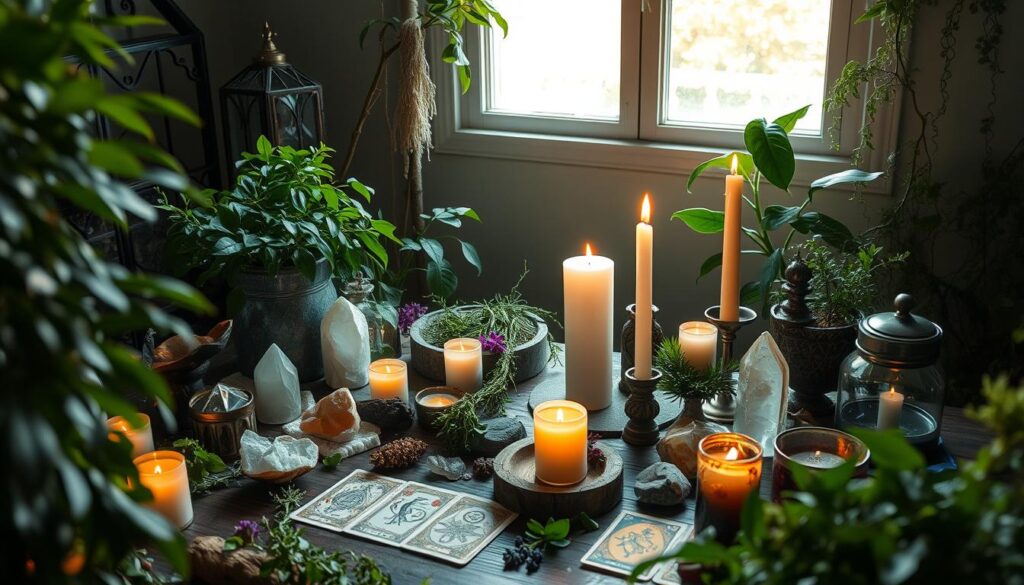
“Witchcraft beliefs diminish social capital manifested in low trust levels and antisocial attitudes.”
Is Witchcraft Real? Understanding Modern Practices
Modern witchcraft isn’t about witches cackling and using supernatural powers. It’s a nature-based spiritual practice. It includes rituals, ceremonies, and spellcasting to honor the moon and seasons. Many modern witches, including Wiccans, see it as a way to live in harmony with nature.
Some witches do cast spells, but they’re more like folk magic or prayers. These aren’t the dramatic spells you see in movies. Witchcraft is very personal and important for connecting with the earth.
Today, modern witchcraft practices have changed a lot from the past. Many see it as a form of nature-based spirituality. They focus on rituals that honor the earth and its rhythms.
If you’re curious about witchcraft, learning about modern practices can be interesting. It shows how witchcraft is part of everyday life. From spellcasting to rituals, it’s a fascinating topic.
“The practice of witchcraft is deeply personal and can be an important part of an individual’s spiritual identity and connection to the earth.”
Wiccan Rituals and Ceremonies
Wiccan rituals and ceremonies are key in modern witchcraft. Wiccans, a type of witch, meet in covens for these rituals. They include:
- Casting spells for good outcomes
- Honoring the moon and seasons
- Connecting with nature and the elements
- Celebrating festivals like the solstices
These rituals help witches connect with the earth and nature’s rhythms. They use the natural world for personal or group benefits.
| Characteristic | Description |
|---|---|
| Malevolent Magic | Using magic to harm others |
| Targeting Community | Witches are seen as targeting their own community |
| Inherited Powers | Witches are believed to have powers through inheritance |
| Perceived Immorality | Witches are often seen as immoral |
| Communion with Evil | Witches are thought to have communion with evil beings |
Today’s witchcraft is different from the past, but it still fascinates people worldwide. By learning about nature-based spirituality and modern witchcraft practices, we can appreciate its complexity and diversity.
The Beliefs and Practices of Wiccans
Wiccans are part of Paganism with their own beliefs and practices. They stand out from other witchcraft types. At the heart of Wicca is the Wiccan Rede, which says “Harm none and do as you will.” This rule guides their actions, ensuring magic doesn’t hurt others.
The Wiccan Rede and Ethical Principles
The Wiccan Rede is key to their ethics. It teaches to avoid harming others and follow one’s will. Wiccans don’t curse or do magic that causes harm. They focus on positive spells and rituals.
Wiccans follow a ritual calendar with eight seasonal festivals, or sabbats. These mark the seasons’ changes. They often meet in covens to celebrate these festivals and perform rituals. Wiccans have different beliefs, from a mother goddess and horned god to goddess monotheism and pantheism.
| Wiccan Beliefs | Wiccan Practices | Wiccan Ethics |
|---|---|---|
|
|
|
Over the last fifty years, Wicca has grown in Europe and North America, especially among teenage girls. Its flexibility and lack of strict rules attract those seeking autonomy and personal freedom within a religion.
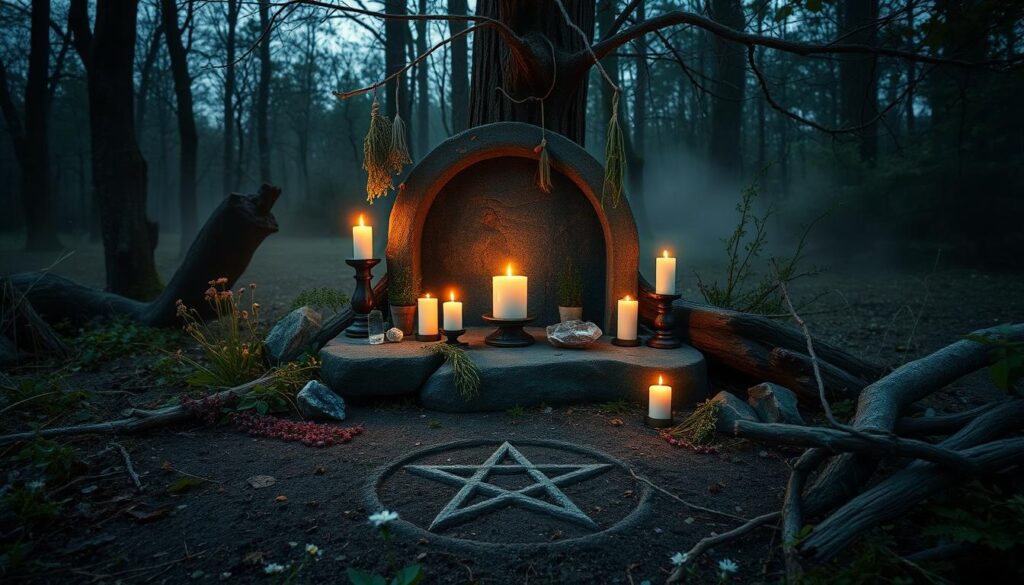
Casting Spells: Myth vs. Reality
Modern witches cast witchcraft spells differently than what you see in movies and TV. These spells are more like folk magic or rituals. They’re not the magical spells shown in popular culture.
Spells can be simple, like lighting a candle for someone you care about. Or using herbs in a ceremony to celebrate a season. These spells connect us to nature and have deep spiritual meaning for the witch.
Witches take spells seriously because they know they can have good or bad effects. They understand the power of nature and their own energy in these practices.
“The practice of magick involves raising and directing energy to fulfill intentions. Witches believe in the energy present in nature, orgasms, and self for magick.”
Real-life witchcraft spells and rituals are subtle. They focus on energy and setting intentions, not on showing off power. Witches believe in nature’s power and their own intuition. They use folk magic and ceremonies to connect with the spiritual world.
Today, more people are becoming interested in witchcraft. This revival is helping to clear up the myths about witchcraft spells and ritual and ceremony in witchcraft. Witches are proud of their practices and are working to dispel the old misconceptions.
The Role of Covens in Witchcraft
In the mystical world of witchcraft, covens are key. They bring witches together to celebrate festivals, perform rituals, and cast spells. These groups offer a sense of belonging and spiritual connection to those in the Pagan community.
Understanding Covens and Their Significance
Covens can have a few members or up to 50. They offer different experiences and views. New witches start training for a year to see if they fit in.
There are different levels of training. First-degree trainees learn the basics. Second-degree witches can initiate others. Third-degree witches are leaders.
A High Priestess and High Priest lead a coven. They run rituals and train members. Covens also have special roles like the Fetch and Maiden.
Not all witches join a coven, but many do. It’s a key part of Wiccan and some Pagan traditions. Covens help witches grow spiritually and build a strong community.
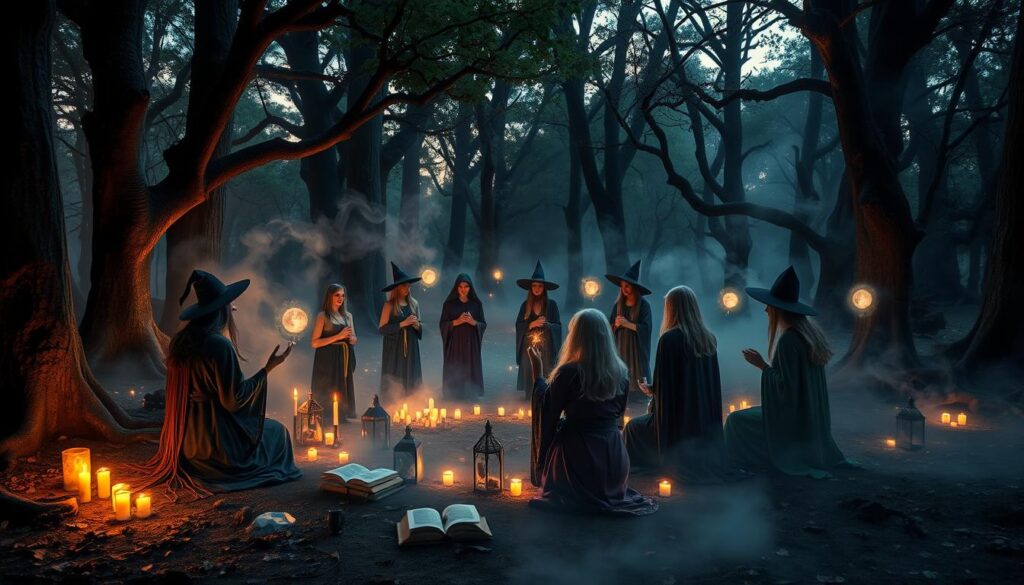
“Ritual writing is highlighted as a crucial aspect of personal development for witches.”
| Coven Role | Description |
|---|---|
| High Priestess/High Priest | Responsible for leading rituals and training members |
| Fetch | Manages coven communication platforms |
| Maiden | Assists in setting up the temple and supporting the High Priestess during rituals |
| Guardian | Similar to a Tyler in Freemasonry, responsible for maintaining security and order |
| Greeter | Welcomes and introduces new members to the coven |
The Historical Persecution of Witches
The history of witchcraft persecution is a dark chapter in human history. Between 1450 and 1750, about 90,000 people were accused of witchcraft in Europe. Half of them were executed. The Salem witch trials in 1692 are a famous example, where 19 people were hanged and others died in jail.
These trials were based on myths about witchcraft. People were accused for many reasons, like conflicts or being on the outskirts of society. Accusations often came from suspicion, rivalry, or property disputes.
Witch persecution wasn’t just in colonial America. It happened all over Europe too. From the 14th to the 18th century, around 110,000 were tried for witchcraft. About 40,000 to 60,000 were executed. The worst witch hunts were from 1580 to 1630, mainly in western Germany and other parts of Europe.
| Region | Witch Prosecution Trends |
|---|---|
| Western Germany, Low Countries, France, Northern Italy, Switzerland | Charges of diabolism were more common, leading to severe witch hunts |
| Spain, Portugal, Southern Italy | Witch prosecutions were infrequent |
Now, the victims of these witch hunts are being cleared of their names. Many places have apologized for the “shocking” trials. The last witch execution was in Switzerland in 1782, ending a tragic era.
The persecution of witches has left a lasting impact on history. It reminds us of the dangers of ignorance and prejudice. We must always stand for justice, compassion, and respect for everyone, no matter their beliefs or social status.
Dispelling Stereotypes: Broomsticks, Cauldrons, and More
The image of a witch often brings to mind a woman in black, a pointy hat, and on a broomstick. But this image comes from popular culture and doesn’t reflect real witchcraft. While some may use these symbols, they don’t show how most witches live or practice their faith.
Witches, including many Wiccans, don’t dress up or use cauldrons and broomsticks daily. They focus on nature, rituals, and magic similar to folk traditions or personal prayers. This is far from the dramatic magic shown in movies and TV.
“The practice of witchcraft is highly personal, with some practitioners being solitary, while others gather in covens or circles.”
Modern witchcraft is about intention and belief in spells, not the magic shown in movies. Practitioners use crystals, herbs, candles, and tarot cards for healing and guidance. They aim to create sacred space and use natural energies for positive change.
- Paganism and witchcraft are becoming more popular, with over a million people practicing in the U.S.
- Unlike the old witch stereotypes, many millennials and Gen Zers are identifying as witches.
- The University of Maryland’s witchcraft club welcomes all genders, majors, and backgrounds, promoting inclusivity.
- The club focuses on positive spells, avoiding curses and hexes.
The image of a witch in popular culture is different from the real modern witchcraft. It’s a nature-based spiritual path for diverse individuals who find peace and strength in nature.
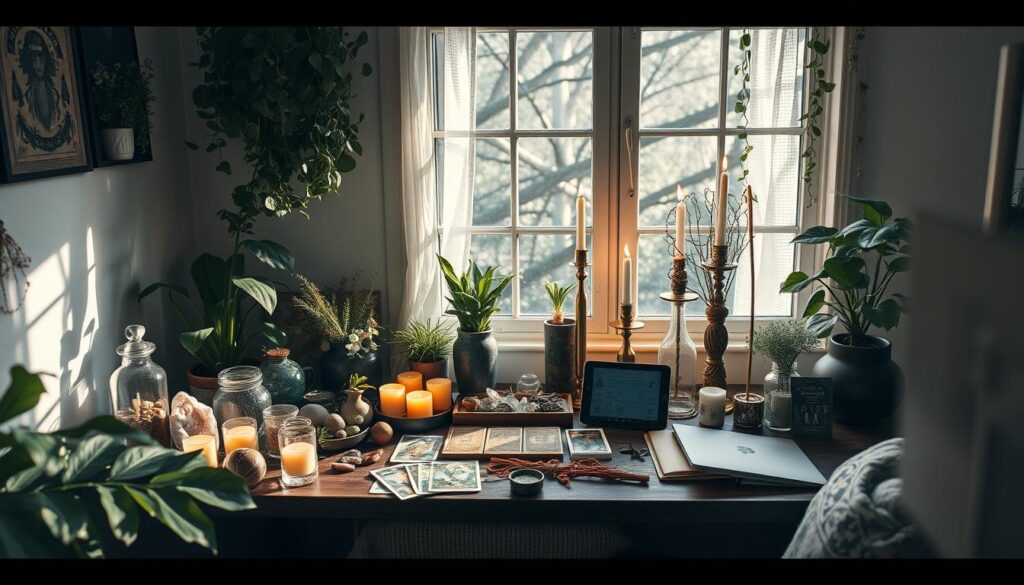
Witchcraft Beliefs Around the World
Many people believe in witchcraft, the idea that some can harm others with magic. This belief is found all over the world, both now and in the past. Even though different cultures have their own ways of practicing witchcraft, they all share a fear of its power.
Global Patterns and Cultural Variations
In some places like parts of Africa and Latin America, many believe in witchcraft. These beliefs are often tied to weak governments and a strong need for group unity.
Witchcraft beliefs show how diverse human cultures and spiritual beliefs are. For example:
- In Africa and Asia, some see witchcraft behind illnesses and natural disasters.
- In Haitian Vodou, there’s a line between good and bad magic spirits.
- The Mapuche in Chile see young women as powerful witches using “bad medicine.”
A study found that over 40% of people in 95 countries believe in witches. But, this belief changes a lot from one country to another. For instance, only 9% of people in Sweden believe in witchcraft, while 90% do in Tunisia.
| Country | Belief in Witchcraft (%) |
|---|---|
| Tunisia | 90% |
| Tanzania | 80% |
| Ghana | 70% |
| Germany | 13% |
| Sweden | 9% |
People with more education and money are less likely to believe in witchcraft. These beliefs stick around in places with weak governments and low trust among people. They also thrive in cultures that value being part of a group.
“Witchcraft beliefs provide a moral philosophy to explain unmerited misfortune in communities lacking heaven and hell belief systems.”
The Social Functions of Witchcraft Beliefs
Witchcraft beliefs have both good and bad sides. They can help keep people in line and bring them together. This happens by making people afraid of being seen as a witch or facing witch attacks.
In places where rules are weak, witchcraft stories can be a way to keep things orderly. The fear of being punished can stop people from doing things that upset others. This helps keep the current way of life and who’s in charge.
Many know the downsides of believing in witchcraft. But, it also has social benefits in certain settings. For example, it can help keep power structures and social peace, even if it limits personal freedom.
“The impact of the Little Ice Age on mentalities concerning witch-hunting is articulated in Behringer’s work, indicating a correlation between climatic change and the practice of witchcraft.”
Johnson and Koyama found that witch trials in France stopped partly because of taxes and lawyers. This shows how institutions and beliefs interact in complex ways.
While witchcraft beliefs have their downsides, they also play a role in society. Understanding their impact helps us see how they shape our social world. This can lead to better ways to deal with their effects.
The Impact of Misfortunes on Witchcraft Beliefs
Many people link misfortunes like illness or economic troubles to witchcraft. They believe these negative events come from supernatural forces. This leads to more fear and keeps witchcraft beliefs alive in communities.
But, the link between misfortunes and witchcraft beliefs is not simple. Things like strong institutions, culture, and economic status also matter. They shape how people see and deal with misfortunes and witchcraft.
Witchcraft accusations can harm family and social ties. In Africa, witchcraft beliefs are common, affecting both educated and uneducated, in cities and the countryside. People there blame witches for many troubles, from crop failures to accidents.
| Type of Misfortune | Relationship to Witchcraft Beliefs |
|---|---|
| Epidemics and natural disasters | Interpreted as acts of witchcraft in many parts of Africa and Asia |
| Job loss | Believed to be due to witchcraft in certain Afro-Brazilian cults |
| Inequalities in life | Explained by the supernatural activities of witches in African cultures |
To fight these misfortunes, people use amulets, medicine, and special baths. They also seek advice to protect against witchcraft in some cultures.
Witchcraft beliefs stick around even when faced with misfortunes. This shows how complex and deep this issue is. To understand why people keep believing in witchcraft, we need to look at many social, cultural, and institutional factors.
Is Witchcraft Real? Costs and Consequences
Many people see witchcraft as a real spiritual practice. But, believing in witchcraft’s power to harm through magic has big costs and consequences. These include strained social ties, high anxiety, and a negative view of the world. They also lead to less trust and innovation, and slow down economic growth.
Witchcraft beliefs can also lead to harmful stereotypes and the persecution of certain groups. They can take away resources from important social and economic issues. Yet, these beliefs help keep cultures together and groups united, especially in places with weak governments. It’s key to understand how witchcraft beliefs work in different settings to tackle their downsides.
The impact of witchcraft beliefs on society is clear from the growing number of Wiccans and pagans in the U.S. The U.S. Census Bureau says Wiccans went from 134,000 to 342,000 between 2001 and 2008. Pagans also grew from 140,000 to 340,000 in the same time.
Witchcraft is becoming more popular among young people, thanks to social media. Hashtags like #WitchesOfInstagram and #WitchTok show its growing appeal. Social media lets practitioners share knowledge and support each other. It also connects them to nature, which is important to those facing ecological issues.
But, the costs of witchcraft beliefs are high. Misunderstandings about it have led to the persecution of many. Scholars believe 40,000 to 50,000 people were wrongly executed for “witchcraft” in Europe and the American colonies from the 15th to the 18th centuries. This shows the severe consequences of witchcraft beliefs on people and communities.
It’s important to understand how witchcraft beliefs affect different cultures and societies. This knowledge helps us find ways to lessen their negative effects. It also helps us see the good in these spiritual traditions.
Conclusion
Witchcraft is a complex topic that covers many cultures and times. Some see it as a real spiritual practice, especially in Pagan and Wiccan communities. Yet, the idea that witchcraft can cause harm through magic is still debated and studied.
This article shows how witchcraft beliefs still exist today, even with our modern ways. These beliefs can lead to problems like strained social ties, more anxiety, and less innovation. But, they also help keep cultures strong and groups together, especially in places with weak governments.
Looking ahead, we need to understand witchcraft’s role better. Researchers, policymakers, and everyone should work together. We need to find ways to lessen the negative effects of these beliefs. This could mean teaching people more, being respectful of cultures, and helping communities directly.
By taking these steps, we can better grasp the world of witchcraft. This will help us be more open and informed about it.
FAQ
Is witchcraft a real spiritual practice?
Yes, witchcraft is a real spiritual practice. It’s different from what you see in movies and TV. Modern witches are often Pagans who follow nature-based religions. They perform rituals and cast spells to honor the moon and seasons.
Were the people accused of witchcraft in the past actually practicing witches?
No, the idea that past accused witches were real witches is a myth. Most accused didn’t see themselves as witches. Some only thought they were after being tortured.
Were more women accused of witchcraft than men?
Yes, during the witch trials in Europe, women were more likely to be accused and executed. But men could also be accused. In some places, men were even more suspected.
What is the difference between a witch and a Wiccan?
“Witch” and “Wiccan” are not the same thing, even though people often use them together. Wicca is a branch of Paganism, a nature-based religion. Not all witches are Wiccans, and not all Wiccans are witches.
Did the belief in witchcraft end with the rise of modern science?
No, witchcraft belief didn’t stop with science’s rise. Legal changes and ending torture were key in stopping witch trials in Europe. But people still believed in witchcraft’s power into the late 19th century.
What is the practice of casting spells like for modern-day witches?
Modern-day witches’ spellcasting is different from what’s shown in movies and TV. They don’t do the magical spells you see in stories. Their spells are more like folk magic or rituals, not the supernatural ones in stories.
What is the role of covens in the practice of witchcraft?
Covens are key in witchcraft, especially in Wicca. They’re small groups of witches who meet to celebrate festivals, perform rituals, and cast spells together. Covens offer a community and shared spiritual life for their members.
Were the victims of the witch hunts in the past ever exonerated?
Yes, victims of witch hunts have been cleared, and many places have apologized for the “shocking” trials. This has happened in recent years.
Do modern witches dress and practice like the stereotypical portrayals in movies and TV shows?
No, the witch image from movies and TV, like the black dress and broomstick, is not real. Modern witches, including Wiccans, don’t wear special outfits or use cauldrons and broomsticks in their daily lives.
Are beliefs in witchcraft widespread around the world?
Yes, people believe in witchcraft’s power to cause harm around the world, now and in the past. The fear of witchcraft varies but is common in many cultures.
What are some of the social functions of witchcraft beliefs?
Believing in witchcraft helps keep cultures together and maintains social order. It’s important in places with weak governments, where it helps control behavior and keep society in line.
How does exposure to misfortunes impact the persistence of witchcraft beliefs?
Misfortunes can make people believe in witchcraft, but it’s not always the case. The link between bad events and witchcraft beliefs is complex. Other factors like culture and economic conditions also play a big part.
